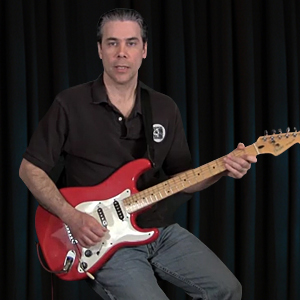Description
In order to build a scale from intervals we need a formula. The major scale formula is:
1st note, whole step, 2nd note, whole step, 3rd note, half step, 4th note, whole step, 5th note, whole step, 6th note, whole step, 7th note, half step, 8th note (which is one octave higher than the first note).
Let's use this idea to play a C major scale. We start with the note C on the A string, 3rd fret. Therefore the note C is the 1st note of the scale (the "1st scale degree"). We move up a whole step (or two half steps) to the 5th fret and this will be the 2nd note of the C major scale (the "2nd scale degree"). This note happens to be a D. Follow the scale formula and we wind up with this:
E|-----------------------------|
B|-----------------------------|
G|-----------------------------|
D|-----------------------------|
A|-3--5--7--8--10--12--14--15--|
E|-----------------------------|
---C--D--E--F--G---A---B---C
Label them all with normal numbers:
This is similar to how the notes of a scale are arranged on a piano: all in a straight line from the left to the right. But on the guitar we can play these same notes in different physical locations.
E|-----------------------------|
B|-----------------------------|
G|-------------------4--5------|
D|----------3--5--7------------|
A|-3--5--7---------------------|
E|-----------------------------|
---C--D--E--F--G--A--B--C
E|-----------------------------|
B|-----------------------------|
G|----------------2--4--5------|
D|-------2--3--5---------------|
A|-3--5------------------------|
E|-----------------------------|
---C--D--E--F--G--A--B--C
E|-----------------------------|
B|-------------------0--1------|
G|-------------0--2------------|
D|----0--2--3------------------|
A|-3---------------------------|
E|-----------------------------|
---C--D--E--F--G--A--B--C
Now that we have taken the concept major scale and applied it to the guitar in a physical form. We have literally taken an aspect of music theory and put it into practice. Let's take a closer look at the major scale we can now play.
First let's assign all the notes numbers, the term "scale degree" and a unique name:
This is how we identify the notes of the major scale in music theory. Notice that this is how we also identified them when we were first thinking about intervals. But instead of labeling all 12 notes of the octave, we are only interested in the notes that make up the major scale at this time.
Every major scale has 2 essential components:
1. Root note.
2. Interval formula.
So we can start on any of the 12 musical alphabet letters A through G#, apply the forumla and get any one of those major scales. This also works for minor scales & any scale or mode.
This tutorial goes into more detail about the C Major Scale:
C Major Scale for Beginners
C Major Scale for Beginners
These tutorials cover the natural minor scale.
A Minor Scale for Beginners
C Minor Scale for Beginners
A Minor Scale for Beginners
C Minor Scale for Beginners
Every type of scale (major or minor, etc.) has a unique interval formula that gives it it's own unique characteristic sound from other types of scales.
